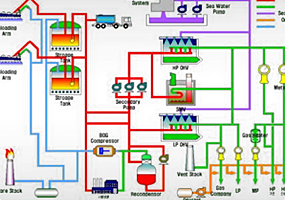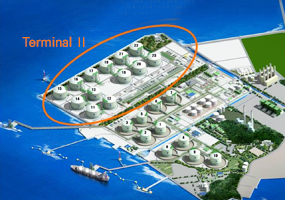KOGAS
Basic Design of LNG Terminal
Localizing Basic Design for LNG Receiving terminal, Applied to Pyeongtaek 2nd terminal, Samcheok, Dangjin and Jeju satellite terminal
-

LNG Terminal concept
-

Pyeongtaek 2nd Terminal
KOGAS has internally devised the basic design technology for the LNG terminal, for which we were formerly depended on foreign companies such as M.W. Kellogg and Sofregaz, and we successfully applied this to the construction of the second plant at Pyeongtaek LNG Terminal. Dependence on foreign technologies was very high in the FEED sector since technology had not been accumulated in that field. By completing the foundation design projects successfully for the second plant at Pyeongtaek (2009) and Samcheok LNG Terminal (2009), however, we have contributed greatly to strengthening our core competencies and enhancing our technological competitiveness. In particular, these projects are very meaningful in that they were exemplary sponsorship projects that were successfully carried out by jointly mobilizing the capabilities of our construction department and the KOGAS R&D Institute.
Building the second plant at the Pyeongtaek LNG Terminal involved construction of 13 storage tanks with a capacity of 2.36 million kL, and a regasification transmission facility with a capacity of 2,160 tons per hour, on a site of approx. 66 ha created by reclaiming land adjacent to the north of the existing first plant by 2013, following the long-term natural gas supply and demand plan. There were two important considerations in completing this project. First, the plant had to be designed in consideration of the linkage between the existing plant (first plant) and the new receiving terminal (second plant) after analyzing the facilities of the first plant. Second, construction of the regasification and transmission facility to vaporize and emit LNG from the first plant had to be completed by 2005, before the second plant’s storage facility had been completed. Our capabilities and competitiveness are therefore highly regarded in light of our successful completion of a complex and difficult project unparalleled elsewhere in the world.
Samcheok LNG Terminal is the 4th KOGAS terminal, and this was a project to build nine 200,000 kL and three 270,000kL storage tanks with a capacity of 2.61 million kL, and a regasification transmission facility with a capacity of 1,320 tons per hour. The project started in 2008, and foundation design was completed by March 2009. Construction began in the second half of 2009, and the first phase was completed in 2013. The Samcheok LNG Terminal has been in operation since its successful launch in July 2014.
Jeju LNG Terminal is the 1st Satellite KOGAS terminal, and this was a project to build two full containment membrane type 45,000 kL storage tanks with a capacity of 90,000 kL, and a regasification transmission facility with a capacity of 60 tons per hour. The membrane tanks in Jeju terminal were the world first full containment membrane type storage tank. The project started in 2013, and basic design was completed by September 2014. Construction began in the second half of 2016, and was completed in 2019. The Jeju Satellite LNG Terminal has been in operation since its successful launch in December 2019.
Dangjin LNG Terminal is the 5th KOGAS terminal, and this was a project to build ten 200,000 kL storage tanks with a capacity of 2 million kL, and a regasification transmission facility with a capacity of 1,560 tons per hour. The project started in 2019, and basic design was completed by September 2020. Construction began in the second half of 2021, and the first phase will be completed in 2025.
By successfully performing the foundation design for the second plant at the Pyeongtaek Terminal, we have demonstrated the ability to perform foundation LNG production terminal design independently, whereas we had previously been dependent on foreign companies. We also have the foundation design performance record to participate in overseas LNG projects. In addition, we saved approximately KRW 6 billion in budget, and KRW 7 billion in foreign currency through this project. Considering the expansion of the second plant in the future, additional budget savings of more than KRW 4 billion can be achieved.
In addition, by competing the foundation design for the Samcheok Terminal, we expect a budget reduction of approximately KRW 14 billion, and an import substitution effect of approx. KRW 17 billion. The economic effect for Dangjin and Jeju was not estimated yet.
Through the LNG tank localization development project, KOGAS became the third company in the world to secure 9% nickel-type and membrane-type storage tank design technology. Then, by demonstrating the foundation design performance of the LNG receiving terminal, we are equipped with an integrated technology system in the downstream sector of the LNG value chain.


